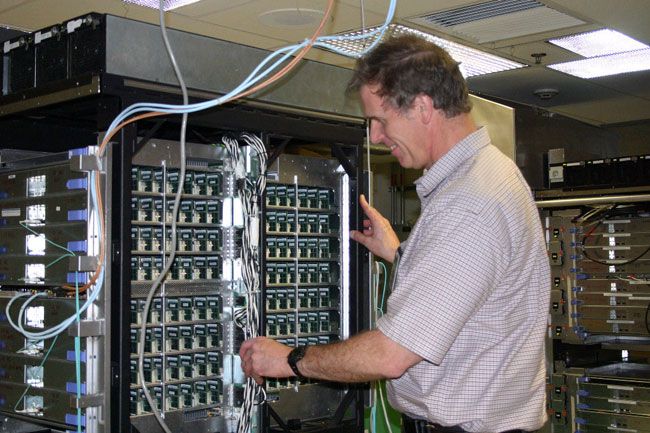New Supercomputer is Fastest Yet

Running about 100,000 times faster than a high-end desktop PC, IBM has unveiled the world’s fastest computer. Already, it's not fast enough.
The new king of the supercomputers is the IBM Blue Gene/P running at a speed of at least one petaflop per second, meaning it can solve one quadrillion floating point math problems per second.
(A quadrillion is a million billions, or 1 followed by 15 zeroes. A “floating point operation” means an arithmetic problem involving two numbers with decimal points, such a 2.5 X 3.14159.)
“Supercomputers are constantly leapfrogging each other in terms of speed, and they are tuned for different types of calculations,” said James Staten, analyst at Forrest Research, a high-tech market research firm. “But it is fair to say that the IBM machine is one of the fastest at the moment.”
Like all modern supercomputers, the new Blue Gene is based on clusters of fairly ordinary computer processors—tens of thousands of them. The Blue Gene/P, in fact, is built around the IBM PowerPC 450 processor running at a rate of 850 million cycles per second. These processor are lined up in racks standing more than six feet high, with 4,096 processors per rack. To reach the speed of one petaflop, the Blue Gene/P (which is three times faster than its predecessor, Blue Gene/L) uses 72 racks, or 294,912 processors.
If that’s not enough, IBM also offers a 3-petaflop version, with 216 racks and 884,736 clusters. And there will be customers for whom even that will not be enough, Staten said.
Never enough
Sign up for the Live Science daily newsletter now
Get the world’s most fascinating discoveries delivered straight to your inbox.
“There will always be problems that suck up all available computing power,” Staten said. “In the supercomputing field you can never have enough processor power, or memory.”
Or money. Staten noted that supercomputer vendors (which includes Sun Microsystems Fujitsu) don’t give out prices since the machines are, typically, custom made for each buyer, but the average price is in the range of $50 million.
Designs are usually prepared when a vendor receives a “request for proposal” from a lab saying it wants a certain level of computational power by a certain date, Staten said. The new machine is then announced with fanfare if an order comes in. If the vendor is lucky, other labs will also decide to buy one, but in many cases a particular supercomputer model will have a market of exactly one machine for one customer.
By that standard, Blue Gene/P has already proven wildly popular—IBM has announced four orders, from labs in the US, Germany, and England.
The machines typically run a custom version of the Unix or Linux operating systems—or even a single-purpose piece of software intended to address the specific problem that the lab bought the machine to solve, Staten said.
- Make Your Own Ethernet Cable
- The Internet is Running Out of Addresses
- The IBM Personal Computer Press Release












